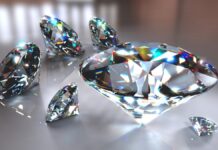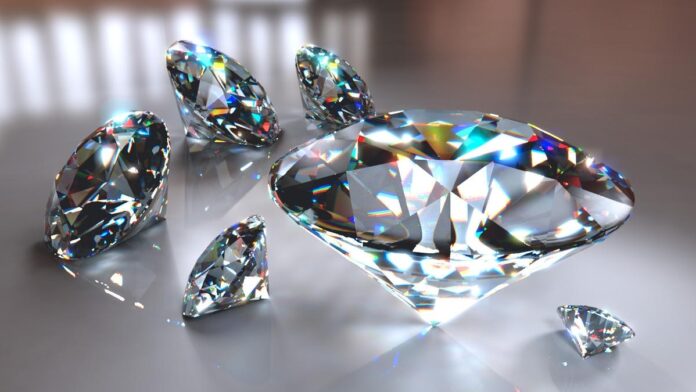What is Diamond?
Diamonds is one of the most popular gemstones worldwide. ‘The big five’ of gemstones are diamond, ruby, sapphire, emerald and jade.
Origin
How is diamonds formed?
Diamond consists of pure carbon, which has been crystallized under very high pressure and temperature. This occurs at a depth of 150 to 200 km. Due to volcanic eruptions; diamonds have been pushed up to the earth’s surface in certain places. The cooled lava containing diamonds is called kimberlite.
Diamond is also found in riverbeds and even in sand deposits along the seacoast. This is where diamonds have been transported over time, under the influence of wind and weather.
Famous Diamond Mine: Kimberley Mine
Diamond was first mined in India and then in Brazil. Only at the end of the 19th century were there any finds in South Africa, cradle of the modern diamond industry. The first major African diamond mine, the Kimberley mine, originated where a boy found a 21.25 carat rough diamond.
The discovery of this stone, the Eureka, was initially not taken seriously by experts. Two years later, a shepherd discovered an 83.5-carat diamond in about the same place. That was the deciding factor and the Kimberley Mine became one of the most famous mines ever.
Suitable for Diamond Jewelry
About 15 to 20 percent of all diamonds that are now found are suitable for use in a piece of jewelry. Despite all modern techniques, diamond mining is still very complicated. On average, just over 6 tons of rough rock has to be processed to extract 1 gram of rough diamond. That is why diamonds are so rare and precious. Also, Gemistone Jeweler has different types of diamond jewelry such as Diamond Rings, Bracelets, Pendants, Stud Earrings, Necklaces, and various colors of gemstones, natural white round diamonds, black diamonds, and their black diamond cuts.
Top of diamond producing countries
In the Northern Hemisphere, Russia and Canada are the two most important diamond producing countries. In the southern hemisphere these are Botswana, South Africa, Namibia and Australia.
By volume, Russia is the world’s largest producer and exporter of rough diamonds. Botswana is the world leader in diamond value. Botswana is also home to the De Beers diamond company and produces the bulk of De Beers’ diamonds. Australia is the world leader in colored diamonds. The country is famous for its yellow, pink, red and purple diamonds.
Diamond: Symbol of love, Symbol of Power
Until the 15th century, diamonds were worn exclusively by kings and other rulers, as a symbol of power, courage and invincibility. Today, diamond is the ultimate symbol of romance. Formed in the depths of the earth, this gemstone has an unparalleled mystical aura.
Everlasting fidelity
The word diamond comes from the Greek adamas, which means indomitable and also denotes everlasting fidelity. The tradition of the diamond engagement ring dates back to 1477, when Duchess Mary of Burgundy was given a diamond ring by Archduke Maximilian of Austria. Following this loving couple, more and more people in love started wearing rings with diamonds. Lovers gave each other rings with pointed diamonds and used these stones to scratch declarations of love into all kinds of surfaces.
Which finger?
The custom of wearing a diamond ring on the third finger of the left hand dates back to ancient Egypt. The Egyptians believed that the vena amoris (love vein) ran directly from the heart to the tip of the third finger on the left hand.
Koh-i-Noor diamond and Hope
Sometimes diamonds were famous than men. Some exceptionally large stones, such as the Koh-i-Noor and the blue Hope, have played a part in the history of royalty, with tales of passion, power, victory and betrayal in their wake.
Quality and value of a diamond: 4Cs of Diamonds
The value of a diamond is determined by a combination of 4 different quality standards.
These are called the 4Cs Of Diamonds:
- Carat weight
- Purity (clarity)
- Color (color)
- Sharps and cut (cut)
-
Diamond Carat weight
For all gemstones, and therefore also for diamonds, the weight is expressed in carats. The word carat is derived from a natural unit of weight: the seeds of the carob tree. In the past, these seeds were used as a unit of weight. Now 1 carat at 0.2 grams (200 milligrams) has been determined, and subdivided into one hundred points. A diamond of 10 points, for example, weighs 0.10 carats (20 milligrams).
How many carats buy a ring?
To choose the size of a diamond for a piece of jewelry, for example a diamond engagement ring, consider the size of the hand or fingers and the choice of ring setting. A small diamond appears larger on a fine hand with slender fingers while a large diamond appears smaller on a large hand with firmer fingers.
Not all ring settings are suitable for carrying diamonds of every carat weight. Make sure you have a correct balance between the ring frame and the size of the gemstone you choose.
-
Diamond Clarity
Almost all diamonds contain minute traces of other minerals, such as graphite. Some diamonds have small hairline cracks. Most impurities only become visible under a magnifying glass. They are called inclusions and they are like the fingerprints of the diamond because they make each diamond completely unique.
What is flawless?
In general, the fewer inclusions a diamond have the rarer and therefore more precious it is. A diamond that shows no inclusions with a ten times magnifying glass is said to be flawless. The clarity of a diamond can be improved with certain techniques. For example, by drilling a narrow channel to a dark inclusion with a laser and then bleaching the dark inclusion with acid, so that it becomes less visible.
-
Diamond Hue (Color)
Although the majority of the diamond appears colorless, they often have a yellow or brown tint. Only a colorless diamond has a perfect prism effect and therefore a lot of brilliance exceptional are diamonds with a natural, bright yellow, orange, green, blue, pink or even red color. These rare gems are called fancy color diamonds and are worth a lot.
Colored diamonds
The color of a diamond can also be improved. Light brown diamonds can be made colorless using a high pressure and high temperature treatment. Tinted-colored diamonds can turn into various fancy colors using the same technique or a combination of high-energy electron irradiation and then heating.
-
Diamond Cut and cut (cut)
Of the four C’s, humans only influence the cut. A newly found rough diamond can look so much like an ordinary mineral or stone that most people wouldn’t recognize it. Only craftsmen are able to reveal the glowing splendor of a diamond. A diamond loses on average about 50 percent of its original weight during the polishing process.
Facets create brilliance
Diamond derives its brilliance and fire from the reflection of white light and the refraction of white light in all the colors of the rainbow. The sharpener is therefore faced with the task of applying the facets in such a way that the light is reflected optimally from one facet to the other. The precision and finesse of the cut determine the brilliance of the stone.
Well Known Diamond Cuts / Shapes
Brilliant Cut
Also called ‘the round brilliant’: the most famous and most popular cut with 57 facets. With its exceptional brilliance and modern, timeless appearance, this shape can be seen in many engagement rings and other jewelry.
Princess Cut (princess)
The princess cut is the most popular diamond cut after the brilliant. The cut is unique per stone. The princess cut stone always retains its square shape, but the number of facets can differ.
Emerald Cut (emerald)
An emerald cut diamond has a rectangular or square cut in which both the pavilion and the corners are polished. This cut was initially designed especially for the emerald because this stone can be very sensitive to damage. The cut corners ensure that the stone is less vulnerable. Later this cut was also applied to diamonds.
Marquise brilliant (marquis brilliant)
The marquis cut is also described as a boat shape and has 58 facets, is long, narrow and tapers to the ends. It is actually also a brilliant cut, only the circumference is different from that of the round brilliant. The sparkle comes from the center of the diamond.
Pear Brilliant
The pear brilliant is a combination of the round and the marquis brilliant. One side is round and the other side is sharpened into a point. In a ring, the tip should point toward the fingertips.
Oval Brilliant
As the name suggests, the oval cut diamond has an oval shape. The bottom of the oval may vary; the more facets at the bottom, the more beautiful the brilliance.
Royal Asscher cut
The Royal Asscher cut was developed in 1902 by the Asscher brothers from Amsterdam. This cut resembles the emerald cut; only the Asscher is square and has no fewer than 74 facets.





























